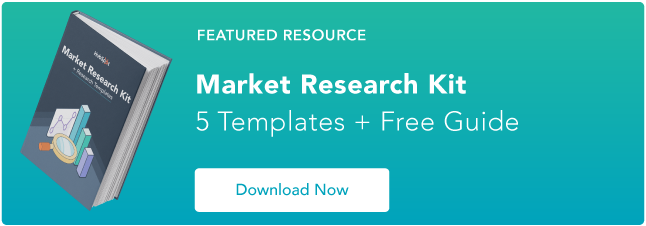What are psychographics?
Psychographics are the psychological and cognitive attributes of a consumer that reveal their beliefs, values, and goals. In marketing, psychographics are used in conjunction with demographics to understand and market to consumers' purchasing habits.
Let's say the business you're promoting is a nutritional counseling program. You've found that your target buyer finds it difficult to engage in a healthier lifestyle. They’ve tried multiple programs before, but none have worked for them. They’re willing to spend more money on nutritional programs, but they want to make sure it works before they invest and want to feel supported throughout the process.
Knowing this information, you then create a marketing campaign that highlights customer testimonials and shows that you’ll be there every step of the way.
Recall that inbound marketing is strategic growth of your organization by building meaningful, lasting relationships with consumers, prospects, and customers as opposed to interrupting them with traditional advertising methods. It’s about valuing and empowering these people to reach their goals at any stage in their journey with you.
The combination of demographic and psychographic information informs your buyer persona — a detailed picture of the audience you serve now and would like to serve in the future.
Knowing both also allows you to do a better job of segmenting your audience, targeting the right customers, and positioning your product in your marketing campaigns.
That said, it’s hard to tell the exact difference between psychographics and demographics. Let’s take a look below.
Psychographics vs Demographics
Demographics explain who your buyer is, while psychographics explain why they buy. Demographics include objective data like gender, age, income, and marital status. Psychographic information includes subjective data like belief systems, values, goals, and attitudes.
Demographic segmentation is a great place to start, as it divides your market into broad strokes, but psychographics gives marketers greater leverage in influencing conversions. For example, demographic information might tell you something about a person's age, but psychographic information will tell you that the person is just starting a family and is in the market for baby products.
Oftentimes, consumers are guided by their attitudes and subjective perceptions when making purchase decisions. Psychographics covers those aspects of the buying process in greater detail.
| Psychographics | Demographics |
| Personality Characteristics | Age |
| Lifestyle | Gender |
| Social Class |
Occupation |
| Habits | Ethnicity |
| Beliefs | Geolocation |
| Behaviors | Education Level |
| Interests | Religion |
By tailoring content for specific groups, marketers are able to convert prospects into customers more cost-effectively. However, it’s worth noting that individuals who fall into the same demographic group don't necessarily fall into the same psychographic group. Prospects might have different habits, interests, preferences, and values that make them unique in how you should target them.
That’s why it’s so critical to create both demographic and psychographic profiles for your prospects and buyers.
Psychographic Profiling
A psychographic profile is a unique description of the attitudes, habits, and interests of an individual or group. It's a collection of consumer values and behaviors that tell you who would be most receptive to your organization's offering.
Because consumers often make decisions based on psychographic dimensions like personal preferences or values, psychographic profiling can be very effective. Understanding your audience’s psychological attributes can greatly improve your outreach methods and advertising style, allowing you to create an overall emotionally compelling brand.
Let’s create a very basic demographic and psychographic profile based upon what we know about the ideal customer for a nutritional counselor.

Demographic Profile:
- Female
- Aged 45-65
- Married
- Has children
- Household income $100K+
Psychographic Profile:
- Dealing with issues of unintended weight gain, diabetes, lack of energy, and hormonal imbalances
- Concerned with health and appearance
- Wants a healthy lifestyle, but doesn’t have much time
- Enjoys going online in the evenings and is a big fan of Pinterest
- Tends to favor quality over economy
- Finds fulfillment in her career and family
- Values time with a small group of friends
Looking at the two lists above, it’s easy to see why you need both. Use demographics alone, and you have only a very hazy outline of your audience — you understand their challenges, but not where to find them and what really moves them to action. Using psychographics gives you so much more insight.

Need a plan for researching psychographics in your audience? Download the market research kit to get started.
Psychographic Factors
Psychographic factors may include personality characteristics, lifestyle, social class, habits, behaviors, and interests. Each of these unique psychological factors greatly influences a consumer’s behavior. You then use these factors to segment your audience based on their psychographic makeup.
- Personality Characteristics - Personality characteristics determine the way a person interacts with the world around them. It's likely that people in your target audience share some personality characteristics that you can tailor your marketing campaign to.
- Lifestyle - Lifestyle psychographics tell the story of how a person views themself within society. This factor can be influenced by relationships, occupation, and other significant life choices.
- Social Class - Although there are no official social classes in the United States, consumers sometimes classify themselves into lower, middle, and upper classes and make buying decisions that are loosely based on them.
- Habits - Habits are psychographic factors that a person has become accustomed to in their daily lives. Habits aren't easily broken, so marketers tend to consider these quite heavily when creating campaigns and advertisements.
- Behaviors - How a person acts is a behavioral psychographic factor. Behaviors are exhibited through a person's buying patterns, product usage, and even the frequency at which they purchase a product.
- Interests - This psychographic factor can influence the way a person interacts with a brand. Interests will vary from person to person, but generally, the target audience will share common interests that can be woven into marketing campaigns to elicit a particular response.
Psychographic segmentation is similar to behavioral segmentation in that groups are created based on more personal or individual criteria.
For instance, if you want to segment your audience using lifestyle as a psychographic factor, you need to decide whether your buyers are attending school, working full-time jobs, engaging in active activities, or living a primarily sedentary lifestyle.
Now that you know the psychographic factors you can use, you can officially begin collecting psychographic data.
Psychographic Data
Psychographic data includes your buyer's spending habits, hobbies, thoughts, values, and other pieces of their psychological makeup. Psychographic data uncovers why a consumer might buy your product, allowing you to create marketing campaigns that appeals to them specifically.
How to Find Psychographic Data
Now that we understand what psychographics are, how do we go about acquiring them? We outline several major methods below.
1. Interview existing clients.
Right now, take five seconds and think of your best current client. Next time you talk, ask them a little more about themselves. You can ask what they did over the weekend and if they’ve seen any good movies lately, found any great holiday deals, or made any New Year’s resolutions.
Depending on your relationship with the person, you can tell them exactly why you’re asking and be more direct. If you’re not in a business where you have that kind of relationship with customers, look for any friends who are similar to your ideal client. You could ask them the same questions.
When you ask the right questions, you can find out what they do for fun, whether they’re a bargain-hunter, what motivates them, and what their personal goals are.
Want a larger sampling? Send out a customer survey and be honest — tell them you want to better understand what they care about. Most people are more than happy to share.
2. Investigate website analytics.
Prefer a more behind-the-scenes kind of investigation? Look at your existing site content and previous special offers. What has moved people to click, call, or buy in the past?
If you haven’t been paying attention to your analytics, it may require some testing. Overall, this method can be extremely effective, as people’s true motivations are revealed by the actions they take. They may not think of themselves as bargain-hunters, but if a discount code got their business, then that reveals their preference for bargains.
3. Use focus groups.
A focus group is a group of people, typically not affiliated with your company, who participate in a discussion about your brand and your products. The participants are to be as unbiased as possible, and they should closely align with your target market. For instance, if you sell hiking gear, your focus group should be made up of hikers — not just anyone who wants to participate.
Focus groups are more effective when you craft a thoughtful questionnaire that helps you uncover the needs and wants of your target audience. Learn how to run a focus group here.
4. Collect data from market research companies.
If you already have a good idea of what your target audience looks like, you can use that information to do research on your own. You can collect the data you need from companies that have already carried out research in your target vertical.
This option can get expensive, so we’d recommend trying a free or low-cost market research tool first. As your needs become more sophisticated, you can then consult with a major company such as NielsenIQ or Qualtrics.
Now that you’ve got the data, it’s time to apply it in your marketing campaigns. We’ll continue with our nutritional program example.
Psychographic Marketing
We've gathered some hypothetical data using the techniques outlined in the previous section, so now let's apply our data to our marketing strategy.
1. Motivate your buyer based on their needs.
You now understand what is important to your buyer, so you’ll know just how to motivate them. You’ll give them what they need to make a purchase decision.
Offering deep discounts isn’t going to move them. Instead, they want to hear that your nutritional counseling service has worked for others. They also want to know that it will improve their health without a huge time commitment. In your campaign, you’ll highlight customer testimonials to appeal to them.
2. Meet them where they’re at.
You know that your target buyer spends their free time on Pinterest. You can therefore stop spending money on Facebook, YouTube, newspaper, and magazine ads.
Instead, share time-saving household and nutrition tips on your Pinterest for Business account. Give them ideas for fun things to do with family and friends.
Watch what they re-pin and analyze what that tells you about them. Did they love the one about the smiley-face veggie platters for an after-school snack? Give them more ways to help their kids eat well. If the “night out” inspirational quote worked well, give them more ways to have fun with their friends.
3. Capitalize on their priorities, hobbies, and interests.
Now that you know that career and family are important to your target buyer, you’ll want to share articles highlighting the impact that good health has on job performance, as well as tips to make exercise fun for kids. In your ads, you’ll want to include images of a healthy parent enjoying time with their kids.
Knowing more about their hobbies and interests will help you choose what to blog about and what images you should use in your next ad. You target buyer loves baking, so you’ll want to include healthy baking recipes in your Pinterest, Instagram, and blog.
4. Include a tailored call-to-action.
Last, you’ll include a tailored call-to-action that’s at the intersection of your target buyer’s needs, priorities, interests, and values. At the end of your ad, you might say, “Your path to a healthy lifestyle starts here — click here to begin.”
You might pair that with an image of the person your target buyer wants to become. That person may be a healthy older version of themselves, a person who has time to do what they love, or a person with a defined physique. The image you choose will depend on the psychographic profile you’ve created for your target buyer.
There are many different ways to segment a market along psychographic dimensions, but there are a few you’ll want to include from the start. Let’s take a look at some popular psychographics examples below.
Psychographics Examples
- Personality traits: What’s your target buyer like?
- Lifecycle stage: Is your target buyer aware they have a problem to solve?
- Interests: What sorts of things does your target buyer like?
- Attitudes or beliefs: How does your target buyer see the world?
- Activities: What does your target buyer do outside of work?
The most popular psychographics are personality traits, lifecycle stage, interests, attitudes or beliefs, and activities. Marketers could also differentiate between groups of consumers based on their buying priorities, social class, and more.
1. Personality Traits
What is your target buyer like? Are they the type of person to research a product extensively before buying it? Or do they like to take risks and try something new? Knowing the personality traits of your target buyer can help you write verbiage that appeals to them specifically.
You can think of personality traits in terms of popular personality tests, such as the Big Five and the Myers-Briggs Type Indicator.
If you’d prefer to spend as little time as possible on choosing personality traits, we’d recommend placing your target consumer on one side of a binary:
- Extraverted vs Introverted
- Emotional thinker vs Logical thinker
- Pragmatic vs Idealist
- Spontaneous vs Planner
- Creative vs “By-the-books”
Come up with your own binaries to decide on the wording and imagery of your marketing campaign.
2. Lifecycle Stage
Lifecycle marketing is all about knowing where your target customer stands in their purchasing lifecycle. Is your target buyer aware of the product or potential solution yet? Have they made contact with your company?
The lifecycle stages are as follows:
- Reach
- Acquisition
- Conversion
- Retention
- Loyalty
Knowing your target buyer’s lifecycle stage can help you decide which marketing channels you should use. Someone who’s not even aware of their problem might be reached through a Google ad or an organic content strategy.
3. Interests
What’s your target buyer interested in? Touch upon those interests in your marketing campaign, and you’ll be much more closer to getting their business.
For instance, if you sell water bottles and decide your target buyer is highly interested in outdoor hiking, you might create a campaign with an image of a person hiking with your water bottle. You’d then target that campaign to those who have expressed interest in hiking gear.
Interests can closely align with activities, though not always. For example, your target buyer might be interested in hiking, but in reality, they don’t have the time or feel confident enough to go hiking on their own.
Other potential interests include their taste in music, shows, and books. You can also dive into other interests such as design, pet care, sustainability, and so forth.
4. Attitudes or Beliefs
Your target buyer’s attitudes or beliefs tells you how they see the world. Knowing the views your buyer upholds can help you create a campaign that resonates with them rather than alienates them.
Continuing the example of the nutritional program above, you might find out that your target buyer upholds the body positivity movement and believes that “healthy” looks differently on different people. In your campaign, you might choose to include photos of people of all sizes who are equally healthy or on the path to healthfulness.
5. Activities
Whereas interests cover events your buyer might not actually partake in, activities refer to what your buyer actually does in their spare time. Do they like to spend time on Instagram to decompress? Or do they prefer to watch the newest Netflix show? In the weekends, are they visiting the most recent museum exhibit or spending time outside in nature?
A consumer's activities can tell you about the things they’ve already spent resources, time, and money participating in. If your target customer loves yoga and you're trying to sell them your nutritional counseling program, you can incorporate images or offers that involve yoga. Alternatively, you might advertise your program at yoga studios.
Psychographics Will Improve Your Marketing Campaigns
Knowing your target buyer’s psychographic profile can help you appeal specifically to them. You’ll choose a better marketing channel, create better imagery, or choose better wording that will help your buyer envision themselves using your product. As a result, you’ll generate more qualified leads than you thought possible, increasing ROI from your marketing campaigns.
Editor's note: This post was originally published in December 2013 and has been updated for comprehensiveness.




-1.webp)
![How to create a content style guide [+ free guide & examples]](https://53.fs1.hubspotusercontent-na1.net/hubfs/53/image1-May-07-2024-07-15-58-1152-PM.webp)

-1.png)



